#lee rang in his “annoying my brother” era
Text
Rang messing with Yeon in the newest episode was pure gold. PEAK SIBLINGS ENERGY.
Rang exceeding younger sibling energy will always put a smile on my face.
It seems that in this season the writers understood how siblings act??? Cause yes, annoying each other is the way to show your affection with your siblings alright?
I need more of this banter and them being annoying little shits. Especially Rang, my dude is the youngest, has a whole bunch of trauma and a lot of anger. My dude has all the rights to be petty and annoy Yeon to death and back.
Can't wait for the fourth episode 😁
#tale of the nine tailed 1938#lee rang#ki yu ri#lee yeon#tail of the nine tailed#lee rang and lee yeon#lee rang needs to act more as the youngest sibling that he is#koo shin joo#lee rang in his “annoying my brother” era#it's good to finally see Yeon realise how him abandoning his place as a mountain god caused problems and killed a lot of people#i know that it won't happen but I really wish they somehow manage to save Rang in the future too#i need Rang to annoy Yeon and Jiah in the future#it would be so funny
61 notes
·
View notes
Text
A Look Back on TREASURE PLANET
So recently I rewatched TREASURE PLANET for the first time in about fifteen years and… I'm not gonna lie, it's still my personal favorite of the 2D Disney animated features from the early to mid-2000s.
Let's be real. Of the 2D features Disney released around that time period, TREASURE PLANET is one of the more solid films. ATLANTIS: THE LOST EMPIRE had some interesting ideas and some really nice design work and animation, but it really needed to be at least two hours long if it wanted to flesh out the characters and the world-building without requiring supplementary material (like a special edition of Disney Adventure magazine). Hardly anybody remembers BROTHER BEAR was even a thing, and the less said about HOME ON THE RANGE, the better. (Seriously, that movie wasn't even worth the Steve Buscemi cameo.)
The only other film of that era that has really held up was LILO AND STITCH, and I'll admit it's probably a better film than TREASURE PLANET. It took more risks in terms of character, setting and originality, and emotionally it leaves more of an impact. (That scene when Nani sings to Lilo makes me cry like a baby every time.) My only problem with it is it always felt like two entirely different movies collided with each other and it never felt like they really meshed well. Otherwise, I agree with most fans that it’s a good film.
Also, of course, there was the excellent THE EMPEROR’S NEW GROOVE, which was just such a huge departure from Disney’s normal schtick and trying something more Tex Avery-esque, only for it to be a perfect storm instead of a total crash and burn. That is much to be proud of.
Going back to TREASURE PLANET, I can understand that most folks walk away saying it’s an "okay" film. I, however, am not one of those people. I've had a real soft spot for this movie ever since I saw it, but now I appreciate this film for additional reasons.
Namely, the animation and effects work. Holy crap, is this movie gorgeous! It's like watching Don Bluth's ANASTASIA, except I don't have to feel guilty about historical inaccuracies. (Now it’s just scientific inaccuracies, but STAR WARS gets away with that all the time.)
Directors John Musker and Ron Clements had apparently wanted to do a sci-fi retelling of "Treasure Island" since before they started working on THE LITTLE MERMAID. With that in mind I do feel like this movie would have fared better with critics back in the early 90s during the Disney Renaissance. However at that time they would not have had such elaborate and detailed CG effects within arm's reach. There's something I really enjoy about the use of 3D backdrops so that they may do sweeping camera movements, and that's not even getting into the lighting effects to establish atmosphere.
What's more, there are a lot of subtleties to the character animation that I never appreciated until now. You could just pick one character and focus on him or her during the whole movie and find a lot of fun little quirks in their dialogue or walk cycles.
Admittedly, much of this film’s appeal probably depends on how much of an animation fan you are. In my case I was watching John Silver’s animation and I suspected that Glen Keane was probably in charge of animating him (as there are moments when Silver looks so much like Ratigan). Those suspicions were confirmed during the end credits and I was delightfully geeking out about it.
It’s also easy to see where this film might not have had a lot of mass appeal. Most of the focus on the story is on Jim Hawkins and his daddy issues, which by the early 2000s was already a cliche of a character arc. And it’s not helped by the fact that Jim himself is... well, kind of on the bland side as a protagonist. There’s not a lot about him that makes him any more or less interesting than any other teenage male lead. But for what it is I think the movie did fine at establishing and building the relationship between Jim and Silver, which does have its warm and comforting moments. For both of them.
And at least the film is straightforward with its plot and characters and it’s not a structural mess like HERCULES, a previous venture by Musker and Clements.
Something I’ve noticed over the years is that TREASURE PLANET has a little bit of a cult following. I distinctly remember this one time when I was taking a storyboard class in college; we were assigned to do a “Master Study” assignment by recreating the key story frames in our favorite scene in a favorite animated movie. One of my classmates picked the scene when Jim is brought home to the inn by the police and embarrasses his mother. I recall being so impressed, and even a little envious, that she got the character design style down to a T. (If you’re wondering what movie/scene I picked for my Master Study, I picked the Big Ben scene from THE GREAT MOUSE DETECTIVE.)
Then, of course, some friends and I suspect that TREASURE PLANET might have fared better if it had been released a bit later, more towards the height of the Steampunk craze. It’s not quite what I would call “Steampunk”, as it takes place in a sort of alternate universe version of the 18th century and not the Gothic era, and most of their transport is solar-powered and not steam-based. Nevertheless it’s easy to see how fans of Steampunk could find it appealing, with its mostly earth-tone color pallet to evoke the painted illustrations of the classic novel it was based on. Also that combination of a pre-20th century aesthetic with out-of-this-world science fiction elements is pretty much, in my opinion, what makes Steampunk so much fun to play around with. Also, a robot made out of copper. End of story.
In terms of why this film didn’t do so well when it was released, I suspect what stunted its success was the marketing. I could be wrong, as I was actually living in Honduras at the time of the film’s release, but we got some TV stations from Denver, Colorado. I remember a lot of the TV spots spent most of their time highlighting the goofy comic relief moments with Morph, and there was a real emphasis on the presence of B.E.N., even though he's in less than one-third of the movie. In other words, the film's success might have been partially sabotaged by a marketing team that seemed to think if you don’t take your film seriously at all that will somehow draw in the crowd.
Although speaking of the comic relief characters, I actually don’t mind them that much. I always thought Morph had a lot of cute, funny moments that weren’t too obnoxious. As for B.E.N., I kind of have mixed feelings for him. On one hand, the directing team made better use of Martin Short’s improvisational skills than PEBBLE AND THE PENGUIN or WE’RE BACK! ever did. But on the other hand, does B.E.N. have to be so loud and shouty? However, while B.E.N. is a real screw-up, he’s not so much to the point where I want to see him get smashed with a sledgehammer. He’s generally likable, not at all loathsome, and just annoying enough, but not TOO annoying.
However while we’re still on the subject of B.E.N., I’d just like to add that the CG animation on him is really nice. Making him 3D gives him a sort of sense of solidity compared to his hand-drawn humanoid compadres, and to top it off his animation isn’t at all stiff or feels like the CG is holding him back. There is some really expressive squashing and stretching going on with his dialogue. It’s so subtle in places that you’d probably miss it if you’re not looking for it. A lot of CG animation studios at the time like Pixar and Dreamworks had not quite mastered squashing and stretching themselves, so kudos to Disney for pulling it off so well.
Now if I may indulge a little on why I remember this film fondly, my favorite characters were always Dr. Doppler and Captain Amelia. They are both fun and engaging on their own, but together they are weirdly adorable. Granted, I've always thought them getting together at the end was a bit rushed, but I still totally buy it.
(What I don't buy is that they'd be so eager to have kids after Doppler showed such annoyance and revulsion towards that toddler alien girl at the beginning. I get that the creators wanted some visual shorthand to indicate that they're an official couple, but they could have just been wearing wedding rings or throw in a little more of them dancing together.)
Part of the reason I love these characters on their own is the casting. I was already familiar with Emma Thompson from Ang Lee's adaptation of SENSE AND SENSIBILITY, and her character of Eleanor Dashwood was very quiet and reserved. You can imagine my disbelief and delight hearing her play an assertive, witty badass as Amelia. (As if I didn't already think Amelia’s design was cool.)
As for David Hyde Pierce, I had only occasionally watched FRASIER growing up, but when I saw this movie I was familiar with him through some other memorable voice acting roles, particularly that excellent Season 8 episode of THE SIMPSONS, “Brother From Another Series.” In other words, I already knew him to be funny, snarky and charismatic.
While I'm on about the casting, I feel like there's a totally wasted opportunity to have these two characters in a room together, say, before the black hole scene, exchanging witty banter to show how compatible they are in a casual setting. It’s a shame that Emma and David didn’t record their dialogue together, because with her being an accomplished writer and with his skills at improvisation, there could have been some good verbal combat by way of “Much Ado About Nothing-Meets-Frasier.”
But looking back, I remember I immediately loved Captain Amelia just on principal. As a kid I never really gravitated that much to any of the Disney princesses. I can’t really describe why, but it was mostly how they were marketed as just looking pretty and (arguably) kind of passive in their own stories. Not to mention how when Disney Princess became a brand, they really amped up the girly cutesy-ness to their preexisting images. Not to say there’s anything inherently wrong with cute or feminine things, but it really made me feel like a weirdo who somehow wasn’t fit to be called a girl.
Captain Amelia, on the other hand, had her own style of femininity by wearing a classy, more masculine captain’s uniform along with thigh-high high-heeled boots (that she has no problem running in). She had a no-nonsense attitude, she was focused and cool-headed in a stressful situation, she was downright snarky and took crap from no one. In other words, she was the type of woman I wanted to be when I grew up, and to this day she is my favorite Disney Lady, bar none.
And while I’m at it, I’m just going to add that I’ve always found Dr. Doppler more attractive than your standard Disney prince. Besides his character design looking like a canine version of Roger from 101 DALMATIONS, he just always seemed like he’d be fun to get a coffee with.
Well, that’s about all I really want to talk about regarding TREASURE PLANET. It’s a shame it’s not remembered by more people as it does have some really good elements to it, but in some regards I can kind of see why it wasn’t a huge critical success. If you haven’t seen it already I recommend checking it out as it’s a pretty solid standalone film that doesn’t need supplementary material and covers all the bases with the plot and some fun character moments here and there. If you’re an animation fan I cannot stress enough how you really need to watch it, or even rewatch it, because, again, the animation and effects work is just a real feast for the eyes.
15 notes
·
View notes
Photo

OPERA / 2017-2018
Alcina
OPEN REHEARSAL
Washington National Opera
Music by George Frideric Handel
Adapted from a libretto by Riccardo Broschi
Inspired by characters and stories from Ludovico Ariosto’s Orlando furioso
So, What’s Going On?
NOTE: At the Kennedy Center Open Rehearsal, you will enjoy Act II of Alcina. However, we've provided you with information on the entire opera.
Alcina (pronounced ahl-CHEE-nah), a beautiful enchantress with a habit of turning people who annoy her into animals and inanimate objects, has succeeded in bewitching Ruggiero (roo-JYEHR-oh), a handsome knight. Ruggiero’s been living with Alcina on her magical island for some time, despite the fact he was meant to go down in history as a virtuous hero.

Costume sketch of Alcina.
All Alcina costumes designed by James Schuette.
This seriously irritates Bradamante (brah-dah-MAHN-teh), Ruggiero’s former girlfriend whom he had promised to marry. She and the magician Melisso (meh-LEES-soh) travel to Alcina’s island hoping to bring Ruggiero back to his senses with the help of a magic ring. Bradamante disguises herself as her brother, “Ricciardo” (ree-CHYAHR-doh); she and Melisso show up on Alcina’s doorstep claiming to be shipwrecked sailors.
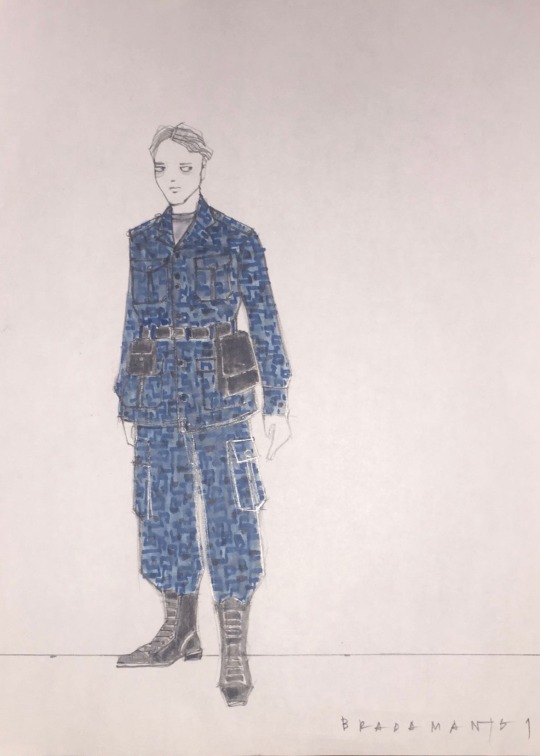
Costume sketch of Bradamante disguised as her brother, “Ricciardo.”
Their plans go quickly downhill, however, when Alcina’s sister, Morgana (mohr-GAH-nah), falls instantly in love with Ricciardo. To make matters worse, Ruggiero refuses to give Alcina up, even after being confronted by his fiancée’s “brother.” Meanwhile, Alcina’s army general, Oronte (oh-ROHN-teh), who’s crazy about Morgana, announces to Ruggiero that Alcina has heart eyes for the newly arrived Ricciardo. Still, thanks to Alcina’s powers of persuasion, Ruggiero pretty much remains under her spell…that is until Melisso, pretending to be Ruggiero’s old tutor, Atlante (aht-LAHN-teh), manages to get Ruggiero alone and slips the enchanted ring on his finger.
Did you get all that?
Take a listen…
Morgana pledges her love to her latest crush, Ricciardo (who’s really Bradamante in disguise). This clip from “Tornami a vagheggiar” (roughly: “Turn to me with longing”) features a repeated melody from a verse heard a few moments earlier. Listen up for the many vocal flourishes used by the soprano.
youtube
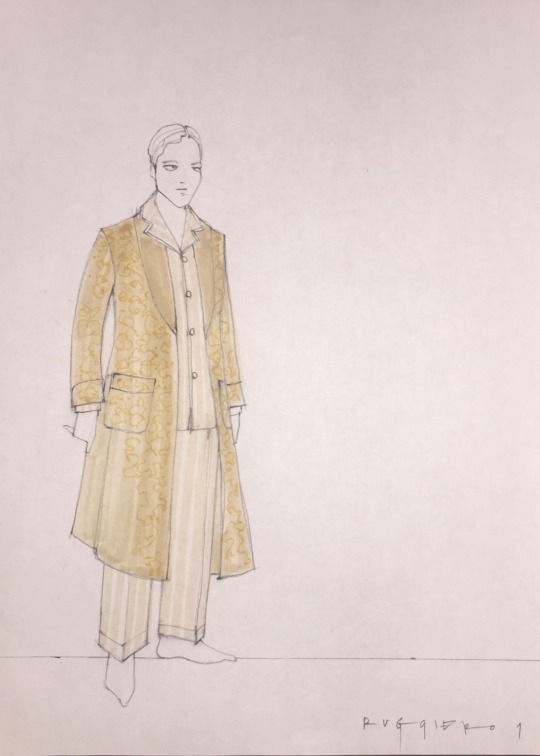
Costume sketch of Ruggiero.
Shocked to discover that Alcina’s island is really just smoke and mirrors, Ruggiero instantly regrets his lovesick behavior. But when Bradamante shows up again and reveals her true self, Ruggiero doubts his own senses and worries that her image is yet another trick.
Bradamante has nearly had enough, but Ruggiero eventually decides to fool Alcina into letting him leave her heavily guarded castle for an impromptu “hunting trip” (while actually secretly plotting to leave the island for good). Alcina eventually uncovers the truth and is furious, but she’s too late—soon Ruggiero has begged for Bradamante’s forgiveness. The two officially become a couple again, and, to add insult to injury for Alcina, the enchantress’s magical abilities begin to fade.
Phew. Are you following all this?
Take a listen…
Alcina tends to her broken heart in the aria “Ah! Mio cor!” (“Oh! My heart!”) (Note: Listen for the mood swing at around 4:22).
youtube
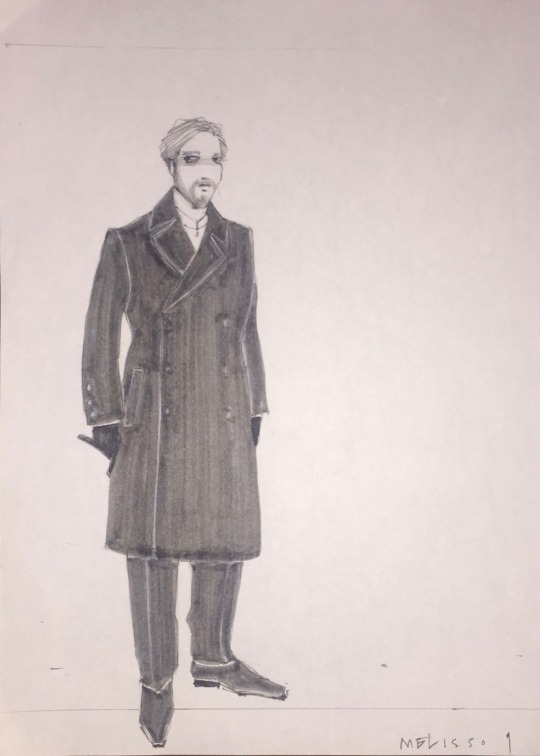
Costume sketch of Melisso.
On the run from the sorceress and her henchmen, Ruggiero, Bradamante, and Melisso develop a plan to conquer Alcina’s army and destroy the mystical urn that lends the enchantress most of her power. But can these three righteous warriors succeed in their efforts? Will they be able to rescue all the captives of the island and escape with everyone’s life and limbs intact? Will the vengeful and heartbroken Alcina let them go?
Take a listen…
Ruggiero meditates on Alcina’s island and its temporary beauty in the haunting aria “Verdi prati” (“Green meadows”).
youtube
Who’s Who
Alcina, an enchantress (soprano—the highest female voice)
Morgana, her sister (soprano)
Ruggiero, a valiant knight (mezzo-soprano—a middle-range female voice)*
Bradamante (also called ‘Ricciardo’), his fiancée (contralto—the lowest female voice)
Melisso (also called ‘Atlante’), Bradamante’s guardian (bass—the lowest male voice)
Oronte, leader of Alcina’s army (tenor—a higher male voice)
*This role would have originally been performed by a male musician trained to sing in a higher, more traditionally female range. Today, this type of performer is very rare, and the male role of Ruggiero is often played as a “pants role,” or a woman who poses as a man on stage.
But stop here for another minute because…
This situation is quite different from the one you’ll see unfold with Bradamante, who is a female character who pretends to be a man during certain scenes within the opera.
Good to Know
Alcina is just one of three Handel operas based on Ludovico Ariosto’s epic work, Orlando furioso (the other two operas, both of which debuted in Handel’s adopted hometown of London were: Orlando and Ariodante). Written just over 500 years ago and told in poetic verse, Orlando furioso may be the perfect story for you if you’re a fan of mystery, magicians, flying hippogriffs, slimy sea monsters, ugly witches who disguise themselves as fair young maids, and/or tales of true love trying desperately to conquer all.
This original text inspired many other works of art besides Handel’s three stage productions. These include yet another opera—this one by Antonio (“The Four Seasons”) Vivaldi—as well as certain scenes in Shakespeare’s Much Ado About Nothing.
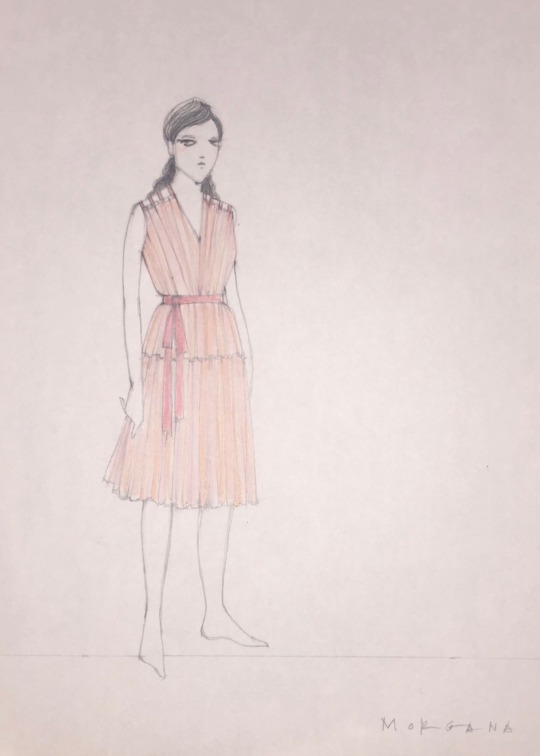
Costume sketch of Morgana.
Check This Out…
Operas written in Handel’s day (referred to as the “Baroque” era) featured solo songs or da capo arias, that could be broken down into two emotionally contrasting sections, with the first section repeated for added emphasis. Listen for how the singers include their own special embellishments to the repeated melodies. Do these improvisations help you uncover new things about the characters and their story?
Alcina’s power supposedly comes from supernatural forces that include evil spirits and a magical staff. How does the music indicate that Alcina isn’t just your average temptress but, in fact, has several tricks up her sleeve (hints: extreme high notes, fluttering string instruments, etc.)? What clues do you see on stage that help reveal her more mystical qualities (think lighting changes, unusual props, makeup, etc.)?
Disguise and deception are important themes throughout Alcina. With so many people pretending to be someone else or trying to hide who they truly are and how they truly feel, it’s difficult for the audience to keep track of what’s true and what’s false (which is sort of Ruggiero’s problem, too).
How do the costumes and gestures of each character alert you to who’s in disguise and who isn’t? Does the music help indicate which characters are lying and which aren’t? How so?
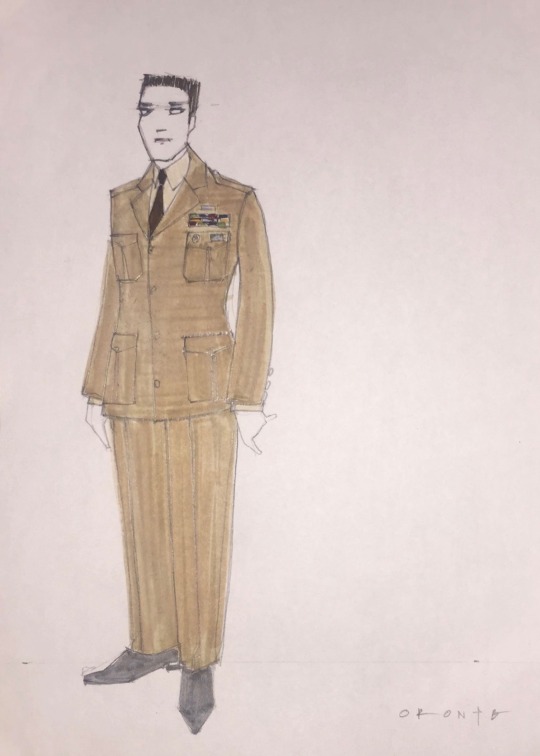
Costume sketch for Oronte.
Think About This…
When Ruggiero realizes he’s been deceived by Alcina, he’s almost more upset at his “dishonor” than at his betrayal of Bradamante’s trust. What do you think of Ruggiero’s concept of honor and reputation? Do you think the creators of Alcina believed that integrity was more important than love? Why or why not?
The music written for Alcina’s character shifts from fiery, to beautiful, to sympathetic, and back again. How do you think Handel felt about his main character? Do you think he sees her as an evil villain or as a tragic figure (or perhaps a bit of both)? How do you see Alcina’s character? Are you able to empathize with her at all or do you think she’s an operatic version of a crazy ex-girlfriend?
A common feature in Handelian operas is the use of the “melisma” (meh-LIZ-mah), a singing style in which many notes are given to a single word or syllable to draw attention to a thought or idea, or to allow the singer to show off his/her vocal range. Do you think the melismas in Alcina—many of which mimic the sounds of sighs or sobs—help you get a better sense of the characters’ emotions? Or do you find these added notes showy and distracting?
Take Action: Going Green
One of Alcina’s most memorable tunes is “Verdi prati,” Ruggiero’s soothing song about the lush greenery of the island. In the aria, Ruggiero warns his listeners that such overwhelming beauty cannot last and suggests all the flowers that surround him will soon die. While his words are clearly a metaphor for Alcina’s dazzling good looks and her intense passions, it may not be a bad idea to think of the aria as a cautionary environmental tale.
Using Ruggiero’s lyrics as your guide, find an outdoor spot you enjoy (such as a park, arboretum, botanical garden, pond or reservoir, wildlife preserve, a neighbor’s yard, or something similar) and see if you can volunteer some of your time toward helping it maintain its health and beauty for years to come. Ask your local government if you can pick up trash, plant seeds, mow lawns, or care for the resident animals. If you feel comfortable, spread the word by taking pictures of yourself as you work on your preservation project and post the pics to Facebook, Snapchat, Twitter, or any social media platform of your choice with the hashtag #verdiprati.
Explore More
Go even deeper with the Alcina Extras.
–
PHOTO (top) by Julio Rodriguez.
–
Major support for WNO is provided by Jacqueline Badger Mars.
David and Alice Rubenstein are the Presenting Underwriters of WNO.
WNO acknowledges the longstanding generosity of Life Chairman Mrs. Eugene B. Casey.
WNO's Presenting Sponsor

Generous support for WNO Italian Opera is provided by Daniel and Gayle D’Aniello.
This performance is made possible by the Kimsey Endowment; The Morris and Gwendolyn Cafritz Foundation; and the U.S. Department of Education.
Major support for educational programs at the Kennedy Center is provided by David and Alice Rubenstein through the Rubenstein Arts Access Program.
Kennedy Center education and related artistic programming is made possible through the generosity of the National Committee for the Performing Arts and the President’s Advisory Committee on the Arts.
© 2017 The John F. Kennedy Center for the Performing Arts
2 notes
·
View notes